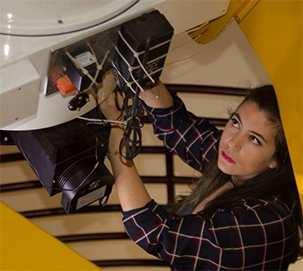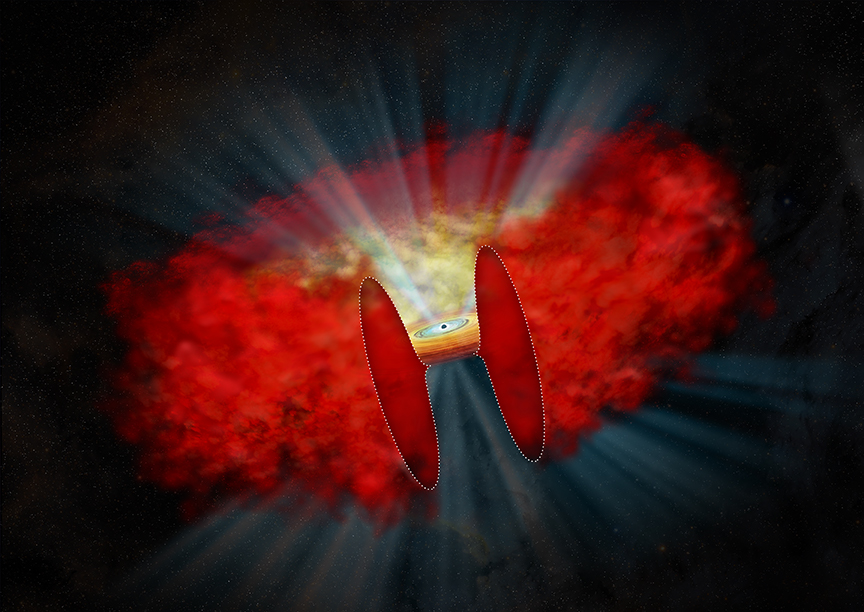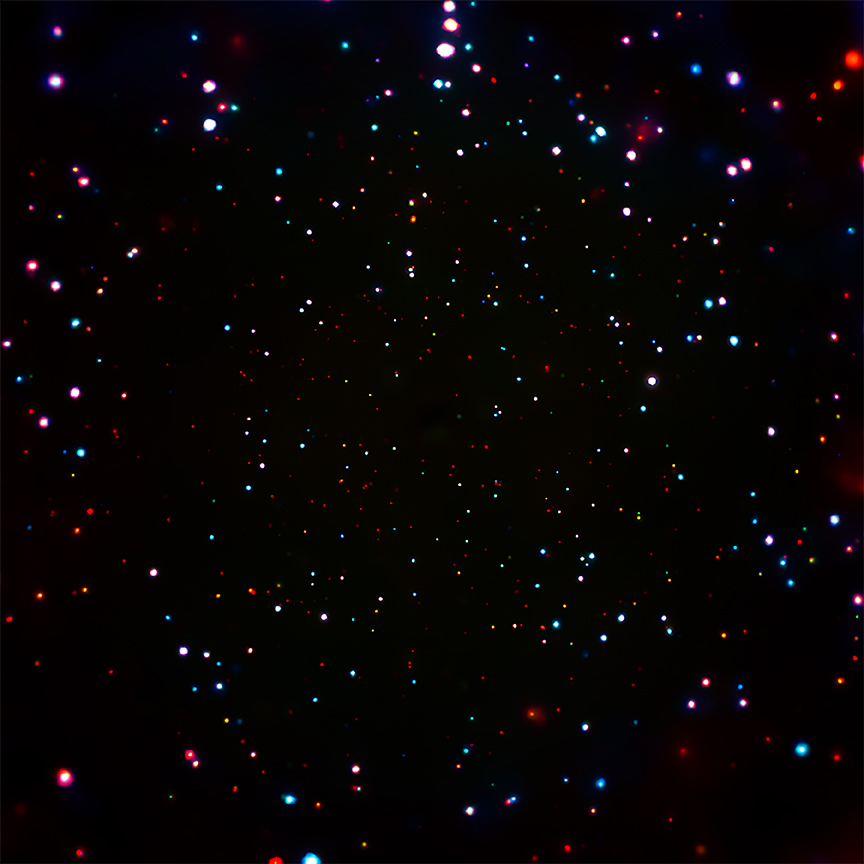Happy Little Accidents: The Happenstance Finding of Obscured Growing Supermassive Black Holes with Chandra
We are delighted to welcome Erini Lambrides from Johns Hopkins University (JHU) in Baltimore Maryland as a guest blogger. She is the first author of a paper in the Astrophysical Journal that is the subject of our latest press release. Erini is a PhD candidate at JHU in the Department of Physics and Astronomy and will be defending her thesis next year. Prior to starting her PhD, she spent a year as a research assistant at Gemini Observatory North, and a year as a research assistant at the American Museum of Natural History in NYC. She got her BS with Honors in Physics at the University of Rochester. She was awarded a NASA Maryland Space Grant Fellowship to fund her PhD and outreach efforts. Her research is focused on quantifying the extent and impact of AGN-host galaxy co-evolution.
When one normally thinks of the scientific method, the following mantra rooted in elementary school days comes to mind: The Question, The Research, The Hypothesis, The Data, The Conclusion. Neatly lined, linear steps that seemingly underpin the entirety of humanity’s quest for knowledge about our physical world. I learned this when I was ten years old, but nearly twenty years later, as I trundle along my own scientific journey, I’ve learned that the steps of the scientific method more resemble an M.C. Escher painting.
My group and I have recently completed work on a peculiar class of astrophysical objects: growing supermassive black holes that are embedded in a thick cocoon of gas and dust. This work is exciting because we discovered that this particularly difficult-to-observe class of objects can be detected in greater numbers than previously thought. However, when I started this work, my goal was not to find these objects, nor was it even about this class of objects!
Initially, I was embarking on a study to test a prediction on how rapidly growing supermassive blackholes, aka, active galactic nuclei (AGN), form in the Universe. I wanted to know if AGN are more likely to live in galaxies that have just undergone a collision with another galaxy, or if they are more likely to live in single, isolated galaxies. This is a question that has caused debate in the astronomical community for decades, and still remains unanswered today. On the way to answering this question with my deep set of galaxy observations, I stumbled across something very peculiar.
In order to test galaxy evolution theories that explain how AGN are formed, we must start with a sample of the most common types of AGN. An easy way to do this is to use an X-ray-selected sample (meaning we identify them primarily by their X-rays). X-ray photons are particularly telling of the existence of AGN due to the high energies that are required to produce them. X-ray information even helps us find less-powerful AGN, which is much more difficult to do in other wavelengths. Thus, by starting with a sample based in the X-ray regime, we are able to probe the weakest to the most powerful types of AGN.
I started with the X-ray AGN sample from the Chandra Deep Field-South (CDF-S). The CDF-S is similar to the Hubble Deep Field in that it is a region of the sky with observations from many different telescopes at various wavelengths over long periods of time achieving the deepest of observations. After I collected all the objects characterized as AGN in the X-rays as defined by the most recent X-ray CDF-S catalogue, I then began to cross-match to other multi-wavelength information to learn more about their properties. The first wavelength we compared our X-ray information to was in the radio regime. Why the radio?
AGN come in many different shapes and sizes. A rare class of AGN, known as “radio-loud” AGN, have large, collimated jets of radio emission that extend far outside the plane of the galaxy that hosts the AGN. These objects represent only a small fraction of the types of AGN that exist, and have already been shown to have a strong connection to galaxy collisions. Some scientists even believe their genesis is different from most other types of AGN. Thus, in order to construct a study to test the morphology of the most common types of AGN, we first needed to remove these rare, extreme objects from whatever sample of AGN we started with.
So, after starting with an X-ray catalog of all the sources detected in CDF-S, we then cross-matched this catalogue to a deep radio catalog from the same patch of sky to identify which AGN are radio-loud. Years of studying AGN across the spectrum have yielded several well-known correlations between the different signatures of an AGN in different energy regimes. Due to their jets, radio-loud AGN have more radio emission than what you would expect based on those known correlations between the radio and the X-ray, infrared or the optical wavelengths.
We compared the radio emission from these objects to their X-ray emission, and were shocked to discover that seemingly half of the X-ray identified AGN could be classified as radio-loud, a supposed rare designation! This was at odds with the litany of information about AGN in the radio sky, so my group and I considered potential explanations for the apparent large fraction of radio-loud AGN that we were finding.
Now many AGN without jets have radio emission. In fact, stars produce radio emission! But in order to be identified as radio-loud, there must be a huge excess of radio emission compared to other wavelengths. This was true for many of our objects in the X-ray regime, but we wanted to be sure of what we were seeing so we also compared the radio emission to another wavelength, infrared (IR). We found that only a few of our sources could be classified as radio-loud when using IR, versus greater than 50% when comparing to the X-ray.
After much discussion, some statistical tests, and a deep literature review, we were forced to consider that perhaps the X-rays were not giving us the full story of what class of objects we were dealing with. What sort of astrophysical source can have enough X-rays as seen by Chandra to be an AGN, but not enough X-rays to correspond to the amount of non-jetted radio emission it produces? The answer is obscured AGN, which are growing supermassive black holes surrounded by a dense cocoon of dust and gas.
By taking deep exposures of the X-ray sky, Chandra is able to recover some of the most energetic astrophysical phenomena in the universe. From binary neutron stars to growing supermassive black holes to entire clusters of galaxies, Chandra can pinpoint these objects directly on large cosmological scales. But hidden in the images of the X-ray sky, the unresolved fuzz in the background of these cosmic events, lies an even deeper mystery — an apparently large population of hidden, obscured AGN.
The unresolved emission in X-ray images is known as the X-ray background, and for over half a century astronomers have aimed to understand which astrophysical objects contribute to it. Obscured AGN are believed by many astronomers to be a significant contributor to the X-ray background. These objects are so obscured by the gas and dust that surrounds them, that even the X-ray photons detected by Chandra struggle to break through the dense cocoon of material. Instead of directly seeing some of these objects, we detect their faint contribution to the X-ray background, and infer their number instead. Different X-ray background models predict different numbers and types of obscured AGN, but the difficult nature of directly detecting obscured AGN makes discerning which X-ray background models are correct an active subject of debate.
Until recently, confirming the most populous type of obscured supermassive black holes has been thought impossible with the current data at hand. But when I found that the X-ray emission for a large set of Chandra sources was not enough to explain the radio emission, I wondered if these objects were the missing obscured AGN population. We know that radio waves are able to penetrate through the thick columns of gas and dust, and we know these objects most likely do not have large radio jets, so it must be the X-rays that are being suppressed. To confirm this, we compared the X-ray emission of these objects to other wavelengths that give information about the properties of the AGN and are not as affected by obscuration. When we compare the X-ray to the IR, we see the same objects that were being wrongly classified as radio-loud also did not have enough X-ray emission corresponding to the IR emission. In fact, every wavelength that had a signature of an AGN process showed an excess when compared to the X-rays. Thus we concluded this was not an excess of emission in other wavelengths, but rather an under-emission of X-rays.
One might ask, if these other wavelengths are able to characterize the AGN despite their obscuration, then why do we need the X-ray at all? Because these other wavelengths alone also do not give the full story. If we were to look at our objects only in the IR, we would not be able to tell which of them were obscured and which ones weren’t. We also wouldn’t be able to securely identify the least-luminous AGN. If we were to only use the radio, we would have difficulty separating non-jetted AGN from galaxies without an AGN. If we were to use typical AGN signatures seen in optical light we would only have a very tiny sample of objects due to the lack of large AGN catalogues with the required sensitivity. In the end, finding and characterizing obscured AGN is a multi-wavelength process. In our work, we found the X-rays are the key to tie all the information from the other wavelengths together.
Although this work started with simply wanting an AGN sample that excluded radio-loud AGN, we ended with instead finding a difficult-to-observe population of obscured AGN that may confirm our understanding of the X-ray background. We found these objects weren’t missing after all, but simply in disguise as something else.
Please note this is a moderated blog. No pornography, spam, profanity or discriminatory remarks are allowed. No personal attacks are allowed. Users should stay on topic to keep it relevant for the readers.
Read the privacy statement



